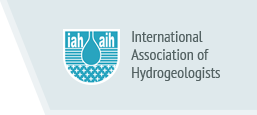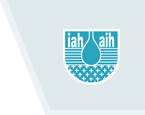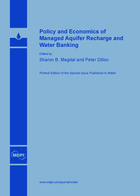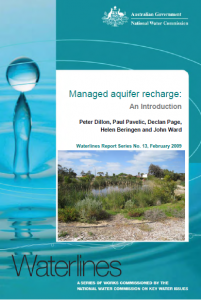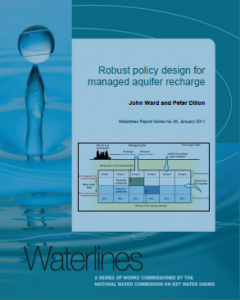Monographs
To download a publication click on its title
Working Group Publications
Clogging issues associated with managed aquifer recharge methods
Martin, R. (ed) (2013) (212p, 10Mb) 
Overview of clogging processes in MAR (1 paper)
Clogging Studies- laboratory clogging experiments ( 4 papers)
Clogging associated with Infiltration Basins (5 papers)
Clogging associated with Well Injection (6 papers)
Clogging Rehabilitation and Remediation Methods (1 summary paper)
Policy and Economics of Managed Aquifer Recharge and Water Banking
Megdal, S and Dillon, P. (eds) (2015) (options for 14 separate papers or 271p monograph)
UNESCO-IAH Publications
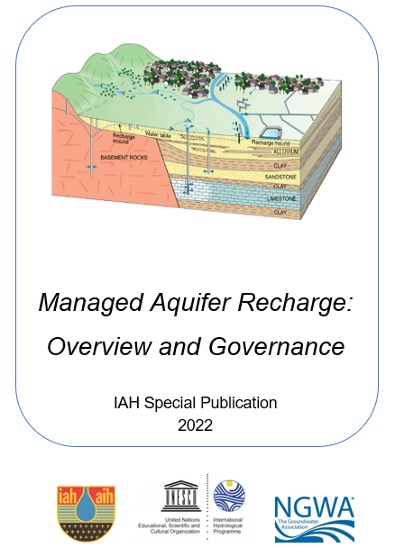 Managed Aquifer Recharge: Overview and Governance. IAH Special Publication.
Managed Aquifer Recharge: Overview and Governance. IAH Special Publication.
Dillon, P., W. Alley, Y. Zheng, and J. Vanderzalm (editors), 2022, Managed Aquifer Recharge: Overview and Governance. IAH Special Publication (90p, 2.4 MB)
This book was produced as a joint effort of IAH, UNESCO and NGWA with encouragement of the Ground Water Project and published as a Special Publication of IAH in June 2022. Its three sections written by different teams give (1) an overview of purposes, types, source waters, advantages, challenges, and essential requirements of MAR; (2) an international synthesis of policy innovations to harness and encourage MAR in water resources management for sustainability in both developing and advanced jurisdictions; and (3) an overview of water quality management strategies for health and environmental protection in MAR from a variety of starting positions and capabilities. This helps to fill the major gaps in governance arrangements for MAR identified in Zheng et al (2021).
Content:
Section 1 Basic Concepts of Managed Aquifer Recharge
Section 2 Considerations for Water Resources Planning and Management
Section 3 Considerations for Water Quality Management
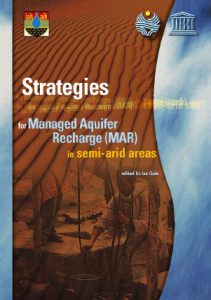 Strategies for Managed Aquifer Recharge (MAR) in semi-arid areas
Strategies for Managed Aquifer Recharge (MAR) in semi-arid areas
Gale, I. (2005) Strategies for Managed Aquifer Recharge (MAR) in semi-arid areas. UNESCO Publication (30p, 2.1Mb) unesdoc.unesco.org/images/0014/001438/143819e.pdf
Objectives of MAR
Water quality issues and sources of recharge water
Hydrogeological settings and controls on recharge
Methodologies for MAR
Institutional Issues in MAR Schemes
Concluding Remarks
Examples of MAR Schemes
References
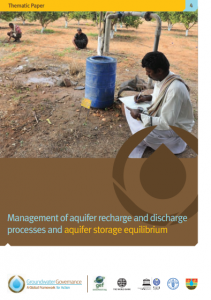
Management of aquifer recharge and discharge processes and aquifer storage equilibrium
Dillon, P., Fernandez, E.E. and Tuinhof, A. (2012). Management of aquifer recharge and discharge processes and aquifer storage equilibrium. IAH contribution to GEF-FAO Groundwater Governance Thematic Paper 4, 49p. (1.8 Mb)
www.groundwatergovernance.org/resources/thematic-papers/en/
Executive Summary & 1. Introduction
2. The state of groundwater governance in relation to the recharge and discharge
processes and aquifer equilibrium states
3. Elements contributing to successful management of groundwater storage
4. Prospects for slowing or reversing trends through improved governance
5. References and Appendices
Other Foundational Publications
Managed aquifer recharge: An introduction
Dillon, P., Pavelic, P., Page, D.,Beringen, H. and Ward, J. (2009). Managed Aquifer Recharge: An Introduction, Waterlines Report No 13, Feb 2009. 65p. (2.7Mb)
http://www.mdba.gov.au/kid/files/772%20-%20Waterlines_MAR_completeREPLACE%5B1%5D.pdf (accessed6 Dec 2016)
Executive Summary and Conclusions
1. Introduction to Managed Aquifer Recharge
2. Drivers and Constraints
3. Economics of Managed Aquifer Recharge in Relation to Alternatives
4. How to Establish a MAR Project
5. MAR Considerations for Regulators
6. Planning for Emerging MAR Opportunities
References and Glossary
Robust water allocation policy for MAR
Ward, J. and Dillon, P. (2011). Robust policy design for managed aquifer recharge. Waterlines Report Series No 38, January 2011, 28p. (670 Kb)
http://webarchive.nla.gov.au/gov/20160615084848/http://archive.nwc.gov.au/library/waterlines/38 (accessed 25 Apr 2017)
Contents: Executive summary. 1 Introduction. 2 The role of managed aquifer recharge in urban water management. 3. Policy changes to facilitate MAR development
4 Robust design: aligning MAR policy with the National Water Initiative.
4.1 Source-water harvesting
4.2 Aquifer recharge
4.3 Recovery of stored water
4.4 End-use
5 Transitional arrangements to an entitlement system
6 Conclusions and recommendations
7 References
Australian MAR Guidelines 2009 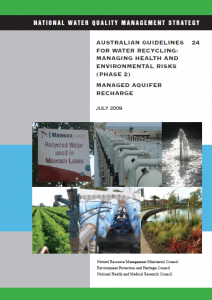
NRMMC, EPHC, NHMRC (2009). Australian Guidelines for Water Recycling, Managing Health and Environmental Risks, Volume 2C – Managed Aquifer Recharge. Natural Resource Management Ministerial Council, Environment Protection and Heritage Council National Health and Medical Research Council, NWQMS Document 24, Jul 2009, 237p. (1.6 Mb)
These Guidelines are to protect human health and the environment at MAR operations for all sources of water, aquifer types, recharge method and end use of water. These are based on risk assessment and preventive measures to manage risk. They account for changes in water quality in the aquifer. They adopt a staged approach to investigations and assessment to ensure safe MAR.
A Water Quality Guide to MAR in India-2014
Dillon P., Vanderzalm, J., Sidhu, J., Page, D., Chadha, D. (2014). A Water Quality Guide to Managed Aquifer Recharge in India. CSIRO Land and Water and UNESCO Report of AusAID PSLP Project ROU 14476. 34p+appendices (1 Mb)
The purpose of this Guideline is to provide simple steps that can be applied by people without specialist expertise in villages of India to improve the protection of their aquifer from contamination arising from recharge operations. This guidance follows a WHO water safety planning approach and uses a simple checklist to make groundwater as safe as can be determined based on visual observations. These guidelines must not be used for recharge of treated urban and industrial waste-waters. These would require extensive water quality analyses to perform risk assessment and management, including selecting water treatment trains to assure water safety. The Australian Guidelines could be used in these cases.
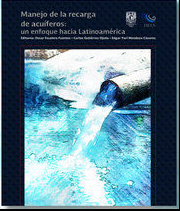 Oscar Escolero Fuentes, Carlos Gutierrez Ojeda and Edgar Yuri Mendoza (Eds)
Oscar Escolero Fuentes, Carlos Gutierrez Ojeda and Edgar Yuri Mendoza (Eds)
IMTA – Instituto Mexicano de Tecnología del Agua, 25 chapters, 978p, 242MB
(in Spanish).
La recarga de acuíferos se conforma de un conjunto de acciones y tecnologías encaminadas al almacenamiento de agua en el subsuelo para su posterior uso, o para remediar la condición de los acuíferos; por ejemplo, para reducir o evitar hundimientos del terreno o impedir la intrusión salina.
